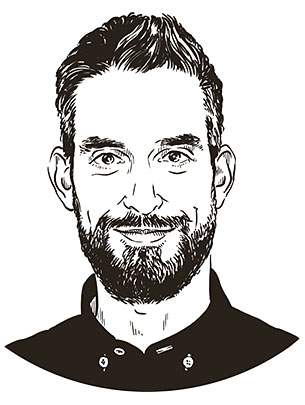Once a risk-taker, always a risk-taker.
Text: Christoph Dieffenbacher
It is well known that some people are more inclined to engage in hazardous or risky behavior than others. Individual attitudes in this regard, however, seem to follow a clear pattern over the course of a lifetime – in a similar manner to intelligence. Psychologists in Basel are investigating how people’s attitudes to risk are formed.
Renato Frey lowers his standing desk. The modern, dark sofa in the office looks tempting, but his guest decides to take a seat at the psychologist’s desk, where the conversation can be illustrated with graphs and curves.
Risk and uncertainty
The observation that experience plays a key role in all of our everyday decisions seems trivial enough. What other factors, however, might be at play when it comes to making “decisions under risk and uncertainty”? This is how specialists refer to choices for which we cannot be entirely sure what consequences our actions will have – the overwhelming majority, in other words. Another pertinent question is whether risk behavior additionally depends on the particular situation, or one’s momentary mental state. And for that matter, are particular groups of people more inclined to take risks than others?
Older people and women are more likely to avoid risks when making decisions, says Frey, citing the latest studies – but points out that the situation is more nuanced than that. As Frey discovered together with other researchers, older people can make certain decisions just as well as younger ones, despite their declining mental agility. However, this is only true for decisions involving a small number of options – when faced with a wider range of choices, age differences become more apparent, he explains.
While the statistics show that men are more likely to take risks than women, “it remains unclear whether such gender discrepancies are caused by biological or cultural factors,” Frey points out, adding that to answer this question, complex models involving a variety of measurement techniques are needed. It also means developing new “game-like risk tests” with which researchers hope to recreate complex real-world situations as faithfully as possible.
Searching for the R factor
“How we normally make decisions in the face of risk can be expressed quite well as a factor, which we call risk preference or risk attitude,” explains the decision researcher. This R factor, which a number of research groups around the world are investigating, can be regarded as a stable psychological trait. Frey and his colleagues recently identified the R factor for the first time, in a study involving over 1,500 test subjects. They showed that the R factor remains remarkably stable over time: “While risk propensity tends to tail off in older people, someone who was a daredevil when they were young is likely to take more chances in old age, too.”
The participants in the study spent a day at a computer performing 39 different risk-related tasks, as well as various lotteries and game-like tests such as the “balloon test”, in which the participant has to fill a virtual balloon with air. A given amount of money is earned with each stroke of the pump – but if the balloon bursts, the money is lost. For this task, learning from experience appears to be an effective strategy.
A notable aspect of this study was that the test subjects were asked to assess their own attitudes to risk. The psychologists observed a strong correlation between these self-assessments and real-life activities involving risk, such as smoking. By contrast, behavior-based risk tests have so far provided a very inconsistent picture in this regard, Frey notes: “People exhibit very different risk behaviors depending on the task at hand, which presents a major challenge when measuring the physiological and biological aspects of risk behavior – for instance using functional magnetic resonance imaging (fMRI).”
Predictive models on the horizon?
It has therefore been a longstanding goal of behavioral sciences like psychology, he explains, to describe people’s risk preferences using models – for example in order to make certain predictions. Asked whether every individual can be assigned to a particular risk type, Frey replies that this may well be the case, citing another study in which his research group examined data from a sample of over 3,100 people in the USA. Model-based cluster analysis, a technique also used in machine learning research, revealed that around two thirds of the test subjects matched one of four basic risk profiles.
Risk behavior is a hot topic among research teams around the world in the field of decision psychology: “It’s an exciting area, not least because it touches on a range of different disciplines such as psychology, economics, biology, medicine and gerontology,” says Frey. Their efforts combine behavioral experiments with modern measurement techniques and imaging technologies, as well as methods such as eye tracking.
Climate change as a systemic risk
Applied research in the field is also on the rise, yielding results that can be applied not just to psychology and economics, but also to areas like technological innovation, drug and transport policy or healthcare. Risk perception – for instance in relation to the 5G standard in mobile communications – is another topical issue, not least when it comes to systemic risks. According to Frey, a problem with these risks is that the consequences of our decisions do not always make themselves felt immediately, often arising only much later – as is the case with climate change, for example.
There is therefore an urgent need to verify the extent to which the stated preferences and behavior of test subjects in the lab coincide with their actual risk behavior in real life. According to Frey’s cognitive models, self-assessments are indeed substantially based on experiences from people’s own everyday lives – an optimistic conclusion – and with that, Frey releases his guest back into a world full of risks.
More articles in the current issue of UNI NOVA.

